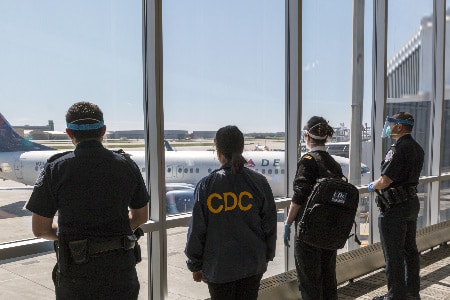How We Serve
Today, globalization makes it easier to move people and goods across the world in a short time. CDC’s Division of Global Migration Health (DGMH) focuses on activities that lower the chance of diseases and outbreaks crossing international borders.
A Journey Through DGMH
DGMH’s day-to-day operations protect the health of people who live, work, and travel to the United States. Let’s explore DGMH’s role in protecting public health.
Immigrant and Refugee Health’s Role
DGMH works to promote and improve the health of immigrants, refugees, and migrants by identifying and treating diseases overseas, to protect the health of the travelers and prevent the spread of diseases into the United States. As part of this work, DGMH develops medical screening protocols and trains physicians overseas to conduct medical exams and screening for immigrants and refugees before they come to the United States. Learn more about Immigrant and Refugee Health.
Port Health’s Role

Learn how DGMQ serves during an Emergency Response.
DGMH responds to ill travelers at US ports of entry, ensures safe importation of animals and cargo, and provides public health information to travelers and the travel industry. Learn more about Port Health.
Southern Border Health and Migration’s Role
DGMH identifies risks that may harm the health and safety of international travelers, including those who travel between the United States and Mexico. The United States and Mexico share a land border of nearly 2,000 miles and infectious diseases such as Zika, tuberculosis, influenza, and measles affect both sides of the border. DGMH addresses these health concerns along the border through binational partnerships with state and local public health agencies in the United States and Mexico. Learn more about Southern Border Health and Migration.
Travelers’ Health’s Role
DGMH monitors disease outbreaks around the world to communicate the most up-to-date travel health recommendations that travelers can use to better plan and prepare for trips. DGMH provides clinicians and travelers with international travel advice, including health information by country, and vaccine recommendations and requirements. Learn more about Travelers’ Health.
How DGMH Works to Protect the US from Travel-Related Diseases and Outbreaks
Protecting the Health of the Traveler
DGMH focuses on reducing illness and injury in US residents traveling internationally and living abroad. By providing the most up-to-date health information on their destinations, DGMH helps travelers stay healthy before, during, and after their trips. DGMH provides international travel health advice, including vaccine recommendations and requirements, behavioral precautions, and advice for specific events abroad.
- Analyzes disease spread to communicate to the public changing disease risks at destinations throughout the world
- Creates and updates travel notices to inform travelers and clinicians about current health issues and protective measures related to specific destinations
- Updates the CDC Health Information for International Travel (or the CDC Yellow Book) which is a major medical reference, providing the most current and comprehensive travel health guidelines for physicians
Amid a yellow fever outbreak in Brazil, DGMQ worked with the US Food and Drug Administration to make an imported yellow fever vaccine (Sanofi Pasteur’s Stamaril) available in the United States and avert a vaccine shortage. The Stamaril vaccine is available in nearly 250 clinics in all US states and territories. DGMQ’s proactive planning and coordinated response ensured US travelers had access to yellow fever vaccine to protect them when they visited countries where yellow fever is still a risk.
Protecting the Health of Refugees, Immigrants, and Migrants
Nearly one quarter of the world’s population is infected with tuberculosis (TB) bacteria. DGMQ has tools to prevent TB importation into the United States. Coordination between the United States and other countries about patients with TB improves treatment outcomes for people crossing international borders.
Since the implementation of enhanced overseas TB screening starting in 2007, there has been a decrease in TB among foreign-born people in the United States. By detecting and treating TB to cure people overseas, overseas screening of immigrants and refugees can reduce US healthcare costs.
- Collaborates with overseas physicians who perform pre-departure medical screenings for immigrants and refugees headed for the United States. TB screening is a required part of the medical exam.
- Improves TB care by using the CureTB program to connect globally mobile patients with the care they need across the globe. The program also educates patients individually on TB to increase their likelihood of completing treatment.